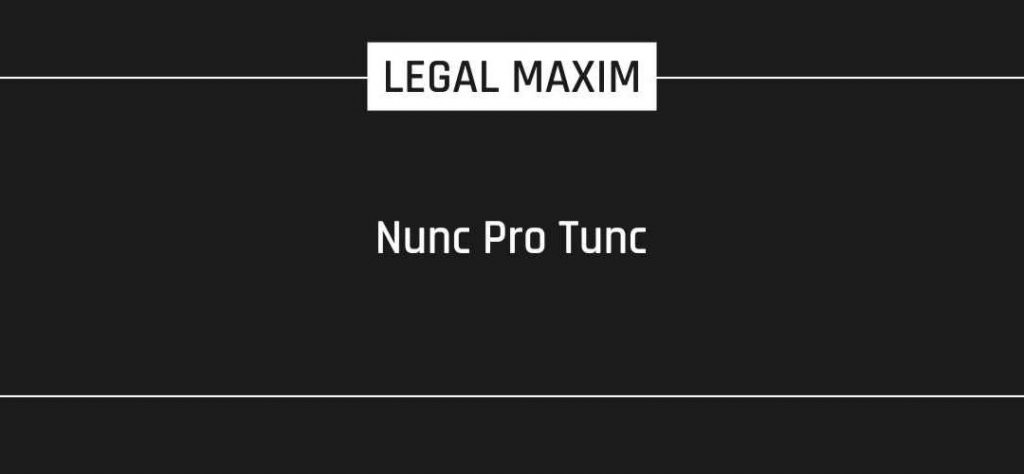
Understanding Nunc Pro Tunc in Legal Parlance
A phrase in Latin, ‘Nunc Pro Tunc,’ stands for “now for then.” However, it is also used as a term to mean correction of judicial orders. Using the same in terms of Intellectual Property Rights (IPRs) corresponds to the assignment of such assets.

Let’s Pick a General Example
The Nunc Pro Tunc assignment assumes the spotlight when a party back-dates an assignment to try to cure a standing defect. Consider Plaintiff A, who sues for the infringement of a right safeguarded by Patent Laws. Defendant B, upon research, uncovers that Plaintiff A does not actually own the same on account of some defect in the chain of title. Therefore, Plaintiff A then responds by getting the Nunc Pro Tunc assignment signed by back-dating the assignment to a date before the lawsuit was lodged and filed. To give you a head up: This does not work as a good legitimate practice in all jurisdictions.
Nunc Pro Tunc: In Business Parlance
For a trademark registered on 1st January 2015, Nunc Pro Tunc assignment typically shall look like this:
“Now, therefore, for good and valuable consideration, the ASSIGNOR agrees that ASSIGNOR hereby assigned unto the ASSIGNEE Nunc Pro Tunc effective as of 1st September 2022, all right, title, and interest in and to the trademark XXX bearing registration no:******. In testimony, whereof, the ASSIGNOR has signed this instrument on 1st September 2022.”
Herein, the assignment is deemed to have been executed on 1st January 2015; but is deemed to have been effective from 1st September 2022.
In business terms, Nunc Pro Tunc assignments are usually used where past Intellectual Property (IP) assignments are made verbally or by mode of conduct. The same is not very unusual since it may so happen that proprietors keen to make an immediate move in the market may “leave for later” or may forget to reduce agreements in writing. In such scenarios, Nunc Pro Tunc assignments are commonly drawn and deduced to bridge the gaps in the “chain of title” for an IP asset. It can also happen when entities and/or assets are sold – but proper paperwork is misplaced. In such an event, purchasers often consider themselves as the obvious owners of such patents, trademarks, or copyright belonging to the former owner but the missing documents lead to ‘gaps’ in the chain of title. These ‘gaps’ can be cured by obtaining a Nunc Pro Tunc assignment from the original owner of the IP asset in favor of the later purchaser of the transaction. In the same manner, Nunc Pro Tunc assignments are often utilized to reach an amicable settlement in litigated matters involving claims over an IP asset, be it a patent, trademark, and/or copyright.
Nunc Pro Tunc: To Reach a Settlement in Litigation
For the purpose of litigation, Nunc Pro Tunc assignments are generally utilized to give a party a legal standing to initiate litigation, i.e., the right to sue or be sued. To have a legal ‘standing’ to initiate litigation, a party to the suit must have proof of rightful ownership or proof of title and/or interest in the patent, trademark, or copyright subject. However, as discussed earlier hereinbefore, for courts, ‘standing’ is passed based on the effective date of the assignment and not the earlier date listed in the Nunc Pro Tunc assignment.
Conclusion: An Acceptable Practice or Not?
It can be simply contemplated that where a non-owner or licensee is given the right to sue, it would give impetus to enmesh the judiciary in abstract legal battles while creating a risk of multiple litigations. It would also provide an incentive for parties to acquire assignment rights to expand their scope of operation and litigation. Inevitably, it would result in a delay in justice delivery and an increase in expenses. The same would defeat the cause of the judicial organ.
It is for this reason that in some countries, such Nunc Pro Tunc assignments are recorded, while in others, no acquiescence of retroactive effect assignments is admitted.
Documenting deeds of assignments after a transaction that has been assumed to be in effect is most certainly not a best practice and can affirmatively lead to several issues. However, it is the only way to attempt to fix an error that has occurred sometime in the past.

